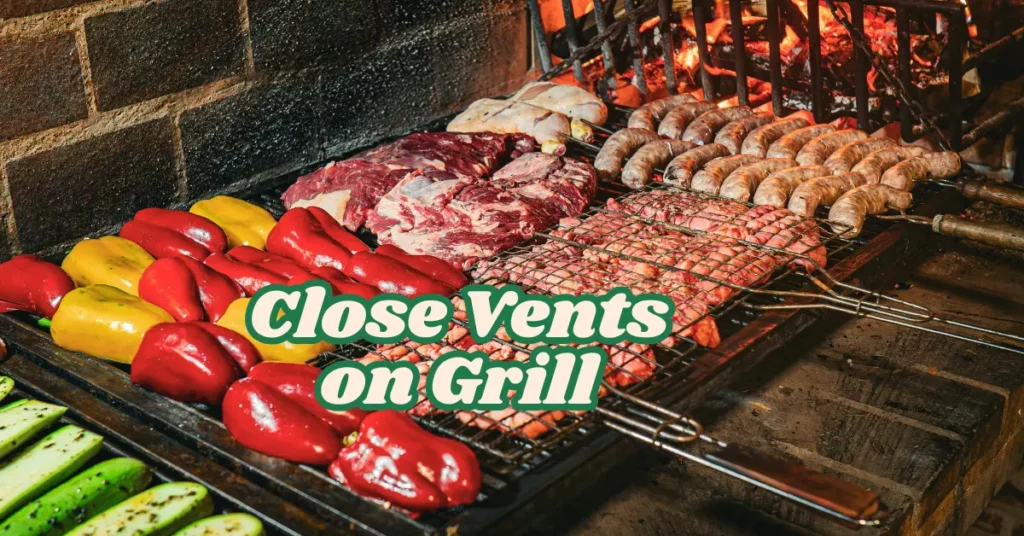This post may contain affiliate links. If you use these links to buy something we may earn a small commission. Thanks.
Grilling is an art, and like any good artist, a grill master must understand their tools inside and out. One of the most overlooked, yet essential, elements of grilling is vent control. If you’ve ever struggled with fluctuating temperatures, undercooked meat, or fires that suddenly go out, chances are the problem wasn’t your meat or fuel but your vents.
So, when should you close the vents on your grill? This comprehensive guide will break it all down from start to finish so you’ll know exactly how to use your vents to take full control of your cookout.
Understanding How Grill Vents Work
Before we dive into timing, it’s important to understand what grill vents do and why they matter.
A. The Role of Bottom Vents (Intake)
The bottom vent is essentially the oxygen valve for your fire. The more you open it, the more oxygen flows in, feeding your charcoal or wood and making the fire burn hotter and faster. Close it too much, and you risk smothering your flames.
- Fully Open: Maximum heat and fast ignition.
- Partially Open: Controlled, medium temperature cooking.
- Closed: Starves the fire, lowers temperature, and eventually puts out the flame.
B. The Role of Top Vents (Exhaust)
The top vent serves as the exhaust. It allows heat, smoke, and gases to escape the grill while drawing fresh oxygen through the bottom vent. Together, both vents create a convection system—just like an oven, but powered by charcoal.
- Open Top Vent: Encourages airflow and helps maintain even cooking.
- Partially Closed Top Vent: Retains more heat and smoke inside.
- Fully Closed Top Vent: Reduces airflow and can make the fire unstable.

When to Close Vents on a Grill
Now that you know how the vents work, let’s go step-by-step through the grilling process and identify when and how to adjust or close the vents.
A. During Startup
Keep all vents wide open. When lighting charcoal or wood, your fire needs all the oxygen it can get. Whether you’re using a chimney starter or lighter fluid, the key to getting a strong, even flame is allowing airflow.
Why keep vents open during startup?
- Allows coals to ignite evenly.
- Builds a solid fire foundation.
- Prevents excessive smoke buildup.
Don’t even think about touching the vents until your coals are ashed over and glowing red.
B. While Cooking
This is where vent control becomes a balancing act. Depending on what you’re cooking and the temperature you want to maintain, you’ll adjust the vents accordingly.
1. High-Heat Grilling (500°F and above):
- Bottom Vent: Wide open.
- Top Vent: Mostly open.
- Best for: Steaks, burgers, hot dogs, and kebabs.
2. Medium-Heat Cooking (350–450°F):
- Bottom Vent: Half-open.
- Top Vent: Half-open or slightly more.
- Best for: Chicken, sausages, vegetables.
3. Low-and-Slow BBQ (225–275°F):
- Bottom Vent: Slightly cracked open.
- Top Vent: Mostly open.
- Best for: Brisket, ribs, pork shoulder.
Closing the bottom vent too much during cooking will suffocate the fire and lower your temp too drastically. Only small adjustments are needed to dial in your target temperature.
C. For Smoking
Smoking is all about temperature control and airflow. You want your grill to run cool and steady.
Recommended setup for smoking:
- Bottom Vent: Open about 1/4 of the way.
- Top Vent: Open 3/4 or fully.
This allows smoke to flow gently across your food without stalling out the fire. You might be tempted to close the top vent to trap more smoke, but that’s a rookie mistake—it actually causes stale smoke and bitter flavor.
When to close vents in smoking:
- NEVER fully close the top vent.
- ONLY reduce bottom vent slightly to manage low temperatures.
- Use a water pan and quality thermometer for stability.
D. When Cooking Is Finished
Once you’re done grilling, this is the only time when it’s correct to completely close both top and bottom vents. Why? Because this chokes out the oxygen supply and extinguishes the coals, preserving any leftover charcoal for your next cook.
Steps:
- Close the bottom vent first.
- Close the top vent right after.
- Let the grill cool down naturally.
This process not only saves fuel but also prevents flare-ups or accidental reignition.
Factors That Affect Vent Adjustment
Grilling isn’t done in a vacuum several external and internal factors will influence how you adjust your vents.
1. Type of Grill
- Charcoal Kettle Grills: Have precise vent control and are great for both direct and indirect cooking.
- Kamado Grills: Super sensitive to vent adjustments due to ceramic insulation. Small changes have big effects.
- Offset Smokers: Use separate fireboxes and rely heavily on both intake and exhaust venting to control temps.
2. Weather Conditions
- Wind: Can fan your flames or disrupt airflow. Block wind when possible.
- Cold Temperatures: Require more airflow to maintain temp.
- Rain and Humidity: May reduce oxygen and affect coal burning efficiency.
3. Type of Food
Thicker cuts or large roasts need more consistent low heat and often indirect heat. This requires more nuanced vent control compared to thinner, quick-cooking items like steaks or chops.
4. Fuel Type and Amount
- Lump Charcoal: Burns hotter and faster, so you may need more vent control.
- Briquettes: More stable but take longer to adjust to vent changes.
- Wood Chunks: Used for smoking, they need careful venting to avoid flare-ups or excessive smoke.
Common Mistakes to Avoid
Even experienced grillers slip up sometimes. Here are common errors that can mess up your cook:
1. Closing Vents Too Soon During Preheat
Doing this stifles your fire before it even gets going, leading to a frustratingly slow startup and unevenly lit coals.
2. Shutting Both Vents While Cooking
If you close both vents during the cooking process, you’ll starve the fire. This is one of the most common reasons for temperature drops and undercooked food.
3. Forgetting to Reopen Vents When Temperature Drops
If your grill starts to cool too much, it’s a signal that the fire isn’t getting enough air. Reopen the vents slightly to allow more oxygen back in.
4. Ignoring the Impact of Weather
Cold air, wind, and humidity can all throw off your cooking temps. Learn to compensate with slightly more or less vent adjustment as needed.
Tips for Mastering Vent Control
Want to grill like a pro? Mastering vent control takes a bit of practice, but these tips will fast-track your learning curve:
1. Use a Grill Thermometer
Built-in lid thermometers are often inaccurate. Invest in a digital probe thermometer to monitor both grill and meat temperature in real-time.
2. Make Small Adjustments
Vent changes don’t take effect instantly. Make a small tweak, then wait 5–10 minutes to see how the temperature responds.
3. Practice with Different Setups
Try cooking with one side of the grill hotter than the other (two-zone cooking). You’ll learn how vent placement affects different areas of the grill.
4. Take Notes
Keep a grilling journal. Record vent positions, weather conditions, fuel type, and results. This will help you repeat successful cooks and learn from your mistakes.
Conclusion
Vents might seem like simple holes in your grill, but they’re actually powerful tools that give you complete control over temperature, airflow, and flavor. Knowing when to close vents on your grill is key to mastering everything from sizzling steaks to fall-apart ribs.
Whether you’re searing hot and fast or going low and slow, learning how to adjust your vents will take your grilling skills to the next level. Remember: practice, patience, and paying attention to airflow will get you there faster than any cookbook.
So next time you fire up the grill, don’t just think about the food watch your vents. They just might be the secret ingredient to your best cook yet.
